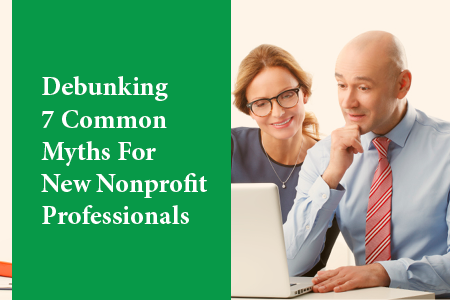 You’re ready to save the world, right?
You’re ready to save the world, right?
Chances are, you’re not starting work with a nonprofit with that level of naivete, but you do want to make a meaningful difference for a cause you care about. Whether you are just starting a career, making a mid-life change, or are looking for one last flourish before retirement, it’s important to dispel some of the common myths about nonprofit professionals. Let’s dive in!
1. Nonprofits are all small and inefficient.
Don’t believe it for a second! The fact is that nonprofits are the biggest employers in a lot of major cities. They’re highly sophisticated in their processes and service delivery. Yes, by sheer numbers, there are a lot more micro-nonprofits than there are substantial ones, but you can say the same with businesses, too.
And efficiency? You’d be shocked to compare dollar-for-dollar how much nonprofit professionals get done when compared to their business counterparts. Want proof? Check out “Zilch: The Power of Zero in Business,” by Nancy Lublin. In this highly acclaimed book, Lubin starts by comparing what she accomplishes as a CEO of a successful nonprofit with “zilch,” to what one of her donor prospect businesses does with millions—and how businesses and nonprofits alike can get more bang with less buck!
2. Work for Nonprofit professionals is easy.
Right along with small and inefficient, somehow people have an idea that work is easy as nonprofit professionals.
Not quite. If you are starting a career with a nonprofit, know that it could be one of the toughest assignments of your life. You’re working where there’s more client demand than resources, not enough staff, tough working conditions, a non-paycheck-motivated labor force (also known as volunteers), and a much-needed mission that may be broadly unpopular.
Any one of these can define “not easy.” Most nonprofits operate under two or more of these less-than-ideal circumstances.
3. Nonprofit culture is nice.
From the outside, nonprofits look like the “anti-business.” Everyone rallies around a mission with respect for each other and the needs of their clients (or patients, or alumni, etc.). Are there nonprofits like this? Certainly. There are also businesses with the same attributes whose mission has nothing to do with society’s greatest needs. Think of it this way: if working at a nonprofit isn’t easy, how can we expect it to always be nice? We can’t.
Nonprofits do tend to draw mission-focused workers, but these same workers can be as demanding, self-serving, and micromanaging as the best (okay, worst) examples in any Dilbert cartoon. Or exactly the opposite.
The point is that any organizational culture, whether business or nonprofit, was started by the founders and carried on by today’s workers. Nonprofit is how the enterprise is legally organized, not a company culture that exists across thousands of organizations nationwide.
4. Nonprofits can’t make money.
There’s a lot of confusion around this point, often derived from the label, “nonprofit.” Without digging into a discussion over the sector’s name, the word “nonprofit” (falsely) implies that you can’t have any monetary overage beyond expenses. That’s just not true.
You see, in business accounting, money made beyond the cost to run a business is known as a profit. Who gets the profits? The owners—whether that’s a single person or millions of stockholders.
The confusion is that nonprofit accounting uses a different word for the money left over beyond its expenses: surplus. Why? Because nonprofits are not owned, there is no one to receive the hypothetical profit.
Can nonprofits have surpluses? Certainly. In fact, a healthy nonprofit should run a surplus. How big it should be is another discussion entirely, but running a deficit or even breaking even can, just like a business, be a sign of trouble.
5. This is my nonprofit.
The truth is, even if you’re the founder of a nonprofit or a business that launched a not-for-profit foundation, it’s not “yours” because nonprofits are not owned.
Nonprofits exist for the community’s benefit, not for any one person or business entity. There are no shareholders. There is no distribution of profits (or surpluses) to board members or anyone else beyond their compensation. Sure, some nonprofits offer bonuses for good performance—but no stock options, because there’s no stock.
As such, in the United States, the attorney general of the state in which the nonprofit is incorporated has legal standing in any matters of a nonprofit. This is because the attorney general represents the people, and the people are beneficiaries of any nonprofit.
This could mean that starting a nonprofit in itself is a charitable act—because the founder has no equity. It is, in effect, a gift to the community you’re serving.
6. All nonprofits are charities.
This one might surprise you, but the reality is that not all nonprofit organizations are charities. In the United States, while around 70% of nonprofits are charities, there are dozens of nonprofit forms that are not.
It’s easy to tell. Most nonprofits that are charities in the US are designated by the tax code as 501c3 organizations. When you donate to them, you get a receipt that allows for a tax deduction. Their services are open to the entire community.
Non-charity nonprofits, on the other hand, usually limit their services to a specific circle of beneficiaries. For example, chambers of commerce (501c6) limit their services to their members. The same goes for credit unions (501c14) and mutual insurance companies (501c15).
The common thread between 501c3 organizations and other nonprofits is that most are exempt from certain taxes as specified by federal, state, and local codes.
7. Nonprofit jobs are easier to succeed in.
Nonprofit jobs take education, training, and experience—just like any other career. Perhaps you are an accomplished professional in whatever it is you do now, or maybe you received a great education in the nonprofit mission, but that still doesn’t make you qualified for jumping in at, or even near the top.
Have you volunteered? That’s great. But even serving as a board member does not qualify you to work at a nonprofit.
Whether you’re just starting your career or coming from another sector, you need to show that you bring a lot more than good intent. Start with training and education on nonprofits, generally, and the missions you love, specifically. Then reach out to people who run nonprofits. Most will be glad to help—but it can take a lot of work to get your foot in the door and begin climbing the ladder.
The Bottom Line
So what’s not a myth? That despite all of the above, nonprofits can be great places to work. Matching your passion for a cause with your daily work can be remarkably fulfilling. You just need to go in with your eyes open.
Don’t look for kumbaya moments every morning. Understand that nonprofit roles, like any career, can be frustrating, satisfying, and valuable all at the same time. Luckily, with the right nonprofit resources, you can set yourself and your team up for continued success as nonprofit professionals. Good luck!
About the Author
 Matt Hugg is an author and instructor in nonprofit management in the US and abroad. He is president and founder of Nonprofit.Courses (https://nonprofit.courses), an on-demand, eLearning educational resource for nonprofit leaders, staff, board members and volunteers, with thousands of courses in nearly every aspect of nonprofit work.
Matt Hugg is an author and instructor in nonprofit management in the US and abroad. He is president and founder of Nonprofit.Courses (https://nonprofit.courses), an on-demand, eLearning educational resource for nonprofit leaders, staff, board members and volunteers, with thousands of courses in nearly every aspect of nonprofit work.
He’s the author of The Guide to Nonprofit Consulting, and Philanders Family Values, Fun Scenarios for Practical Fundraising Education for Boards, Staff and Volunteers, and a contributing author to The Healthcare Nonprofit: Keys to Effective Management.
Over his 30-year career, Hugg has held positions at the Boy Scouts of America, Lebanon Valley College, the University of Cincinnati, Ursinus College, and the University of the Arts. In these positions, Matt raised thousands of gifts from individuals, foundations, corporations and government entities, and worked with hundreds of volunteers on boards and fundraising committees, in addition to his organizational leadership responsibilities.
Matt teaches fundraising, philanthropy, and marketing in graduate programs at Eastern University, the University of Pennsylvania, Juniata College and Thomas Edison State University via the web, and in-person in the United States, Africa, Asia and Europe, and is a popular conference speaker. He has a BS from Juniata College and an MA in Philanthropy and Development from St. Mary’s University of Minnesota. Mr. Hugg has served on the board of the Greater Philadelphia Chapter of the Association of Fundraising Professionals, the Nonprofit Career Network of Philadelphia and several nonprofits.






Leave A Comment